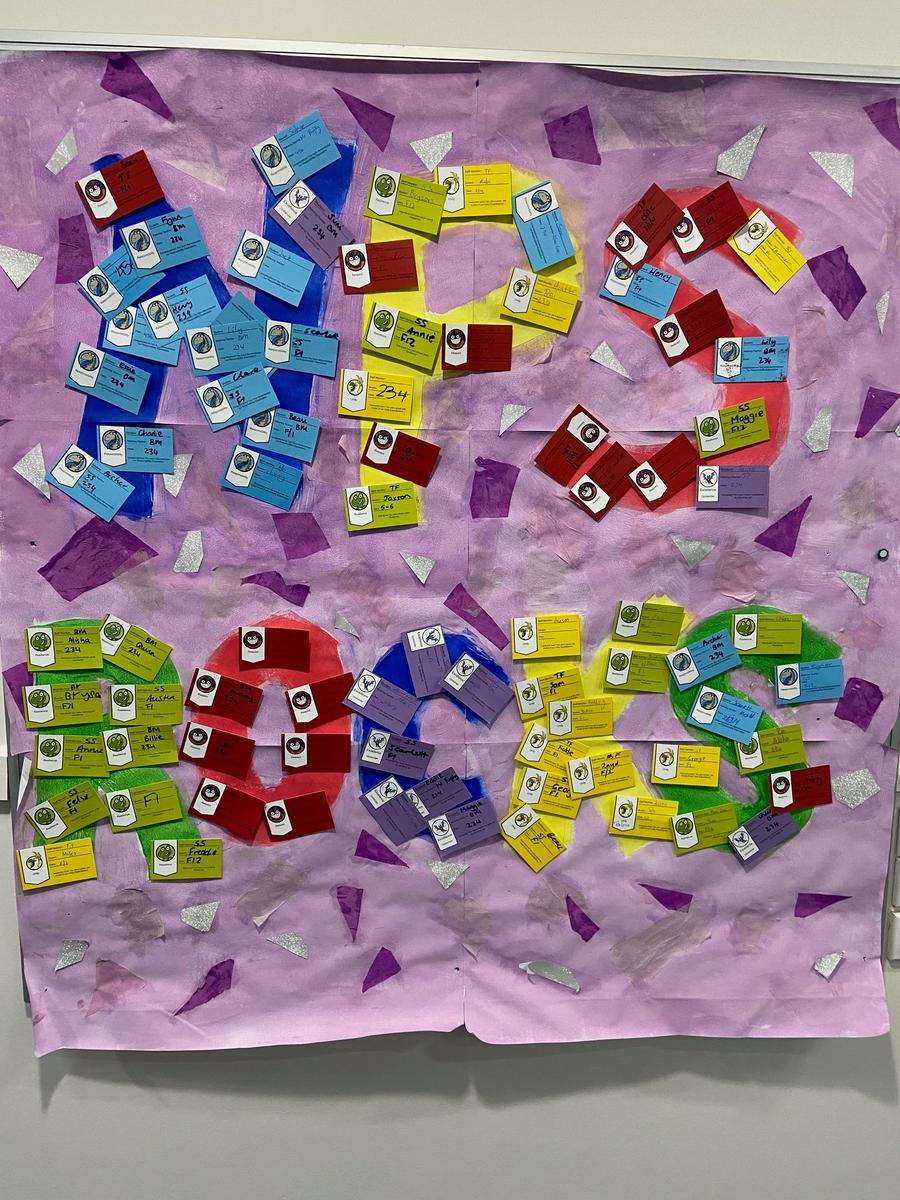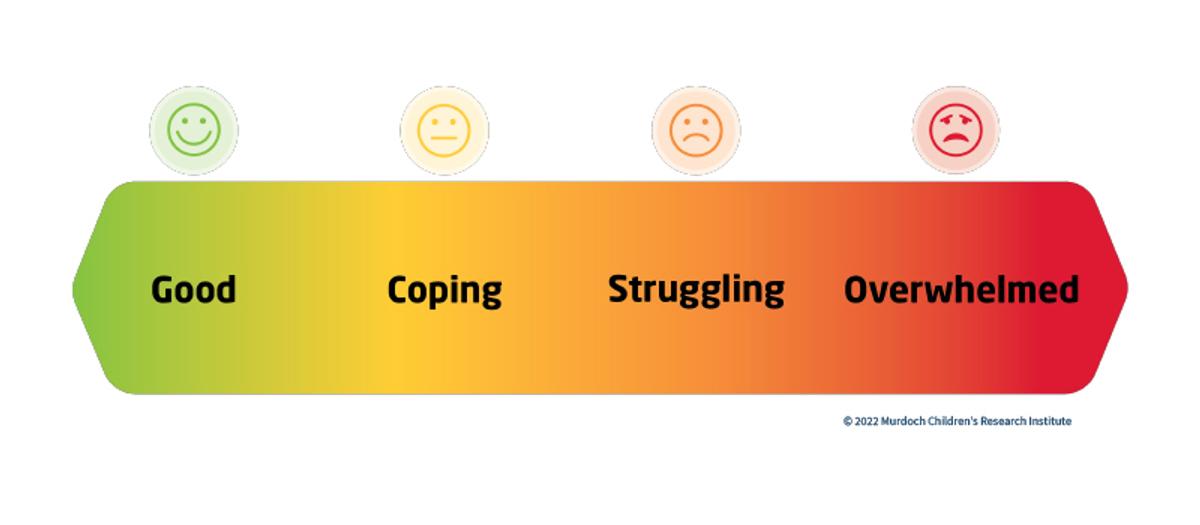Wellbeing

NPS sure does rock. Each of these 80 cards represents 20 value cards from our students. An incredible effort to have this filled, we can now have our whole school celebration, woohoo!!!!! Students have chosen an afternoon of Robot Wars and Kahoots which we will do very soon. Well done NPS.
Children's Wellbeing Continuum
If you ever have a wellbeing concern for your child, no matter how big or small, don't hesitate to reach out to us. We'll do the same. We can work together to get a good picture of what is happening for your child and develop a plan to support them. As a staff, we have been looking at streamlining how we respond when teachers or parent/carer(s) develop a wellbeing concern for a student.
We are using the Children's Wellbeing Continuum to help us. This is a tool developed by The Murdoch Children’s Research Institute and The Royal Children’s Hospital. It gives us a shared language for talking about child wellbeing, reflecting the fact that wellbeing is more than just good or bad, and changes over time. This video is a nice explainer:
Child Development & Wellbeing Information
Thanks very much to all of you who completed the Child Wellbeing Parent Information Survey last term. Following your input, there'll be information in each newsletter on the preferred topics. Teachers are not experts! But it is part of our job to research and practise strategies to support children's development and wellbeing. We'd love to share some of this knowledge with you. If anything sparks further interest, questions or wonderings, don't hesitate to get in touch for further information or a chat. No dumb questions and no judgement here; looking after kids is hard.
This week: Setting and Maintaining Expectations and Boundaries
Recommendations
Watch: Encouraging Positive Behaviour: tips in action (scroll down for ~9 min video). Although this video focuses on young children, these tips apply across the age range. You'd just adjust the language, level of responsibility and expectations, and include more consultation with older children.
Read: Routines - Positive Behaviour Strategies on the Raising Children Network (a website with a wealth of great advice on many topics, including positive behaviour). Building routines is one really useful strategy.
Listen: Pop Culture Parenting Episode 1: Home Alone + Time Out (scroll to the bottom of this webpage or find it wherever you stream podcasts). A few of us teachers at school love this podcast series. It's presented by Dr Billy (a developmental paediatrician) and Nick (a developing parent), is really relatable and has some great advice and a little bit of nostalgia. The series is great - start with episode 1!
Teacher Summary
At NPS, we use the School Wide Positive Behaviour Support framework. The fundamental ideas and essential elements also apply for home.
1.Clarify & Teach Expectations
Meeting behavioural expectations are skills children need to learn just like riding a bike or learning to read. We need to support them to learn these skills; they won’t just be picked up along the way.
- Having clarity in a family around expectations helps everyone to reinforce them consistently – that might mean conversations between carers about what is expected and what isn’t appropriate, and maybe a simple list
- Link expectations and boundaries with family values – especially when adjusting or introducing a new expectation/boundary, it can be important to help children understand the why
- Include children, especially older children, in discussions around expectations
- Positively phrase expectations to name what you want to see, rather than focusing on the inappropriate behaviour. We have a tendency to say “don’t do that” rather than “do this”. Try and be specific about expectations.
- Build routines into your family’s life – they’re especially good for helping children learn responsible independence in complex situations like getting ready for school, bedtime or mealtimes.
- Simple checklists (with words or simple pictures) can help as references for routines or expectations. You might also have visuals like a brainstorm of fun play ideas for when you’re bored / off-screen time, etc.
- Teach the expectations and routines. In the education world, we talk a lot about a gradual release of responsibility model for teaching new skills…I do (adult models) – We do (adult & child do together) – You do (child does independently)
- Role model the expectations. Also admit when you’ve not met an expectation – it’s good for children to see adults make mistakes and own that.
2. Encourage Expected Behaviours
Giving positive feedback to children (and adults) is incredibly motivating and strengthens relationships.
- 4:1 - Behaviour research indicates that we should aim to give children at least 4 bits of positive encouragement to every 1 corrective comment.
- Praise, praise, praise – a simple and powerful way to reinforce positive behaviour. As often as you can, notice when your child is meeting expectations and making great choices. Thank and congratulate them with specific praise, e.g. “I can see you’re …. Nice job!” “Well done on …”. “That’s so great how you just…”
- Rewards – external motivators are a useful tool, especially for a tricky expectation/ boundary. You might have a chart to tick off/stamp so that repeatedly meeting an expectation results in a reward. If you feel uncomfortable about things, rewards don’t have to be stuff. At school, our rewards focus on celebrating positive behaviour by spending some special time together in a class/whole-school party. A reward could be cooking biscuits together, choosing dinner, watching a movie together, going on a bike ride together, going to the park together, etc, etc. It has to be something motivating for the child.
3. Discourage Inappropriate Behaviours
Children will always push boundaries and ignore expectations – it doesn’t matter how clear we’ve been or how much praise we’ve been giving out, it’s going to happen. It’s important to accept this and not see it as a failing. Instead, it’s an opportunity for us to help the child really learn where the boundary is and that the expectation matters. At the same time, we want to be careful to avoid shaming. This means we need to focus on the behaviour (that was a bad choice), not the child (you are bad). We want to make sure the child knows the whole time that we believe they are fundamentally good and capable of meeting our expectations. We want children to know they can make mistakes and make up for them.
- Pause – when things are going awry, give yourself a chance to take a breath before engaging.
- Calm & Neutral tone and expression – try and respond to inappropriate behaviour this way to take the heat out and minimise conflict (it can be really hard!).
- Prompt – use “The Look”, a raised eyebrow, a gesture with your hand, a pointed cough to remind about an expectation before you even have to say anything.
- Redirect & Reteach – clearly state the expectation not being met, e.g. “Remember, we do … in our house”
- Immediately praise and encourage the child once they meet the expectation again
- Provide Choice – If you’ve tried prompting and reteaching, and the inappropriate behaviour continues, offer a choice of following the expectation or a logical consequence if they don’t
- Logical consequences – are related to the expectation not met. For example, if they’ve caused a mess, they clean it up / do some extra cleaning. If they’ve been fighting over a toy, it gets put away for 10 mins. Sometimes, a related consequence is hard and a loss of privilege (something they care about) is suitable.
- Plan possible consequences in advance – often in the heat of the moment we make extreme consequence threats that are out of proportion to the boundary crossed.
- Follow through on a consequence – empty threats can be counterproductive
- Hold firm to your agreed expectations – try not to give in to wheedling and whining, threats or escalation. Otherwise, the child learns that the expectation/boundary isn’t one you really care about, and that those low resilience strategies work to get out of it. Even though it can be really tough (and sometimes feels embarrassing if in public!), stay strong.
- Rupture & Repair – it can be important to debrief after things have really gone wrong. Give some time for everyone to feel calm again and then revisit what happened. Start the conversation talking about a strength you see in the child, and then acknowledging “this wasn’t your moment/day”. Name the mistake and revisit the expectation. Talk through how they and you were feeling. Explore helpful strategies they could try in future. Practise/role-play following the expectation or using a strategy. Tell the child you believe in them.

